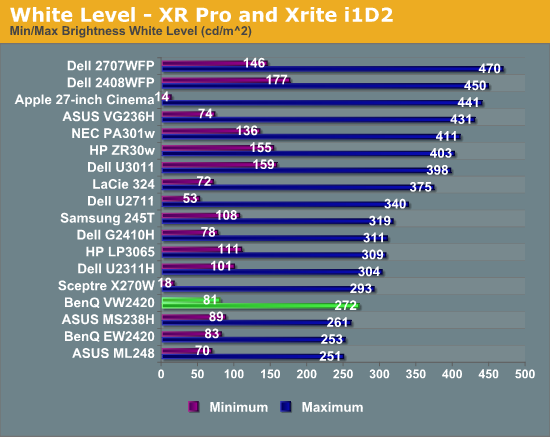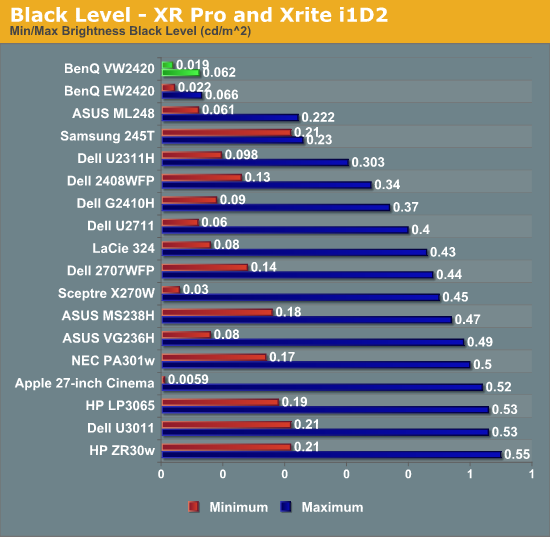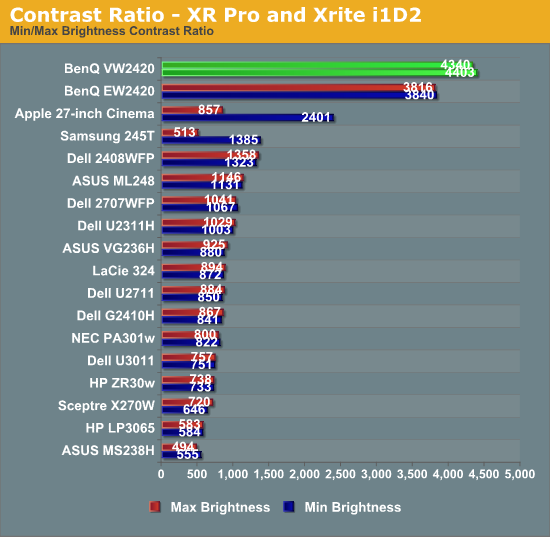BenQ VW2420H Monitor Review
by Chris Heinonen on December 10, 2011 2:45 AM ESTBrightness and Contrast
With the previous LED monitor I saw from BenQ, the exceptional thing about it was native contrast ratios that exceeded 3000:1 at all levels of light output. These superior contrast levels result in better highlight and shadow detail across the screen, and an image with more “pop” than other displays.
With the monitor set to its maximum light output, I managed to record 272 nits of output, which should be more than enough for most users. With the brightness set to the minimum value, we dropped down to 81 nits, which provides enough range for people that want to use the display in total darkness for print work. It’s very unlikely that anyone would need to use a monitor above or below these peak values, so the BenQ provides plenty of light output for everyone. (Note that it's possible to get the white output even lower if you tune the RGB colors in the "User" mode, though we didn't feel this was necessary.)

Of course if the black levels are very high to go with those white levels, you’ll lose a lot of image quality. With the brightness set to maximum, our minimum black level was recorded at 0.062 nits. This black level is lower than many other panels can manage with their brightness set to the minimum value, which is good to see. Setting the brightness to the minimum gave us a reading of 0.019, which is a very good value as well.

Putting these numbers together gives the BenQ a contrast ratio of right around 4,400:1 at both minimum and maximum brightness levels. This is even better than the previous panel and is easily the best contrast we have recorded for a monitor (without any dynamic contrast at play). Unless we start to see LED backlight monitors, or OLED monitors, that can potentially put out absolutely no light on a solid black screen, it might be a while until we see numbers much better than these. There are a lot of LED lit panels out there now, but the BenQ currently performs better than any of them when it comes to contrast ratio.

Contrast ratio is one thing that can really make a huge difference in the quality of the image and is often not valued as much as it should be, but here it is just fantastic. BenQ has a huge advantage over everyone else it seems and hopefully this will motivate everyone to improve their own contrast ratios. [Ed: Please, can laptops get some of this high contrast love?]










48 Comments
View All Comments
mike55 - Saturday, December 10, 2011 - link
BenQ's website says this monitor has an 8-bit panel with 24-bit interpolation. I don't understand why interpolation is used for a panel that's capable of displaying 24-bit color. Could someone explain this, please?marraco - Saturday, December 10, 2011 - link
If I need a machine to tell the color accuracy of a monitor, well, then I don’t care much about it. I’m not sensible on color accuracy.But If I read an Anandtech article about a monitor, then I buy the monitor, and text looks blurry when I scroll web pages, PDF, and word documents, then I blame the Anandtech article which said NOT A WORD about things that matter.
snuuggles - Sunday, December 11, 2011 - link
Man, I couldn't agree more. I'm not sure who these reviews are for. There are so few people that really care about color accuracy.- input lag
- 120hz
- ?? what else matters? I'm personally a little hazy on why any gamer would settle for 60hz when 120hz is just *so* much better.
Now that I think about it, my guess is that the market for people who care about quality monitors (ie, people that know anything at all about displays) and who *aren't* photographers/graphic artists must be vanishingly small, which is why the reviews seem to cater to that crowd.
cheinonen - Sunday, December 11, 2011 - link
There are people who care about color accuracy and those who care about input lag, and those who care about both. I can't venture to assume what percentage of people care about which unfortunately, though I care far more about color accuracy than input lag myself as I rarely game but do a lot of image and general work where the colors annoy me. However, I know I don't represent everyone so I try to cover everything I can.The next display up is a 120 Hz display, so there will be comments on that of course. I'm attempting to find a better way to measure the actual motion resolution on displays, but have run into a couple issues on that so far:
- The test patterns max out at 1920x1080
- The output is limited to 60 Hz
So the 120 Hz display can't take full advantage of the panel for that. I'm trying to find a way to measure that better, as motion resolution is something that is hard to really get across right now.
I'm trying to cover all the bases for reviews, and trying to clear out the backlog of monitors that are here so I can start to better select what the comments are interested in.
sulu1977 - Sunday, December 11, 2011 - link
60 Hz monitors give me eyestrain every time. My next monitor absolutely has to be 120 Hz or higher.Zan Lynx - Monday, December 12, 2011 - link
Exactly how does the refresh rate on a LCD cause eye strain for you? I can see that with a CRT it would because the low phosphor persistence on high refresh rate CRTs would cause flicker when used at a lower refresh rate.With an LCD the pixel stays set until the displays gets a refresh. It doesn't flicker. At all.
You might be seeing a 60Hz flicker of the LCD's fluorescent backlight tubes. If that is the problem, then you need to find a monitor manufacturer that uses a better backlight..
It could also be caused by your eyes being badly affected by interference patterns generated by room fluorescent lighting flicker combining with LCD backlight flicker.
In none of these cases will a 120Hz refresh LCD solve your problem except by a new display coincidentally using a different backlight.
sulu1977 - Tuesday, December 13, 2011 - link
I thought my new LED LCD laptop would finally get rid of eyestrain forever, but I was very wrong. Just passing my fingers across the screen reveals obvious flicker. Without getting into deep technical analysis, the bottom line is this:I can stare at a tree in my yard and never get eye strain/fatigue, but staring at my new 60Hz LED LCD gives me eye strain/fatigue every time.Oxford Guy - Tuesday, December 13, 2011 - link
Next-generation panels from the maker of the panels used in these BenQ monitors are being produced and are about to be produced:http://www.tftcentral.co.uk/news_archive/25.htm#au...
Some have a 5000:1 contrast ratio rating (up from 3000:1). Some are 120 Hz. They have a faster response rating of 6 ms g2g rather than 8 ms, and 12 ms overall rather than 25 ms.
The first announced panel that appears to use one of these is the Phillips 241P4QPYEB/27 and 241P4QPYES/00. The only difference between the two is the color of the frame.